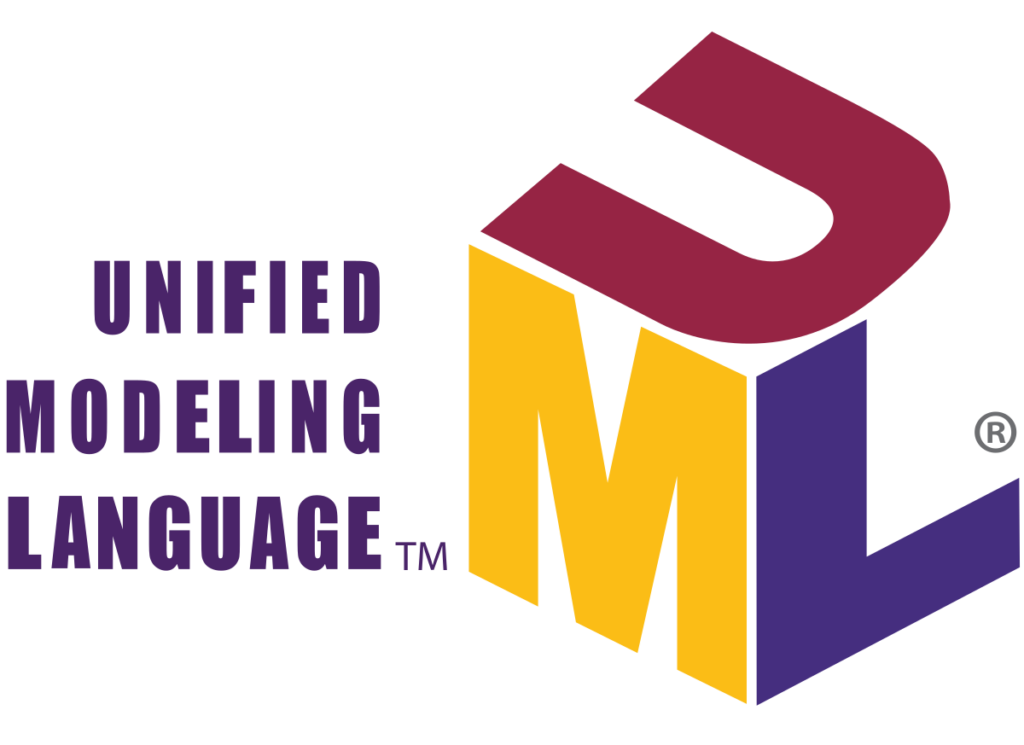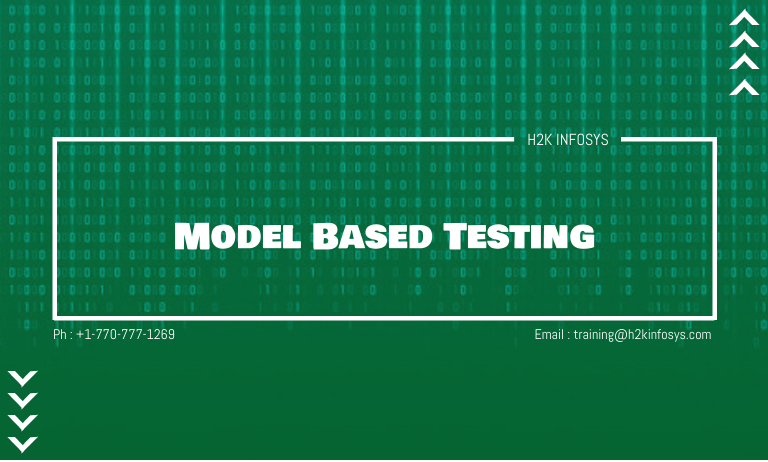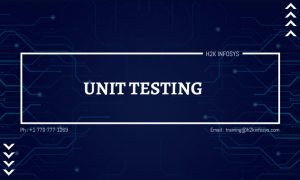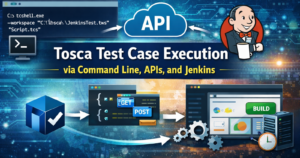Model based Testing is a Software testing technique which checks the run time behaviour of the software under test and is checked against predictions made by the model. A Model is known as description of the system’s behavior and behavior can be described in terms of input sequences, actions, conditions, flow of data from input to output. It should be practically understandable and can be reusable, shareable, must have a precise description of the system under test.
There are many models available and also describe different aspects of the system behavior. Examples are:
- Data Flow
- Control Flow
- Dependency Graph
- Decision Tables
- State Transition Machines
Model Based testing also explains how the system behaves in response to an action. Supply chain and see if the system responds as per the expectations.

Consider an example which explains the simplified approach of writing poetry in the notepad and also possible action related to each step. For each and every action, test case which can be generated and also output is verified.
Types of Model based Testing
Basically there are two types:
- Offline/a priori: Generation of Test suites before executing it. A test suite is the collection of test cases.
- Online/On-the-Fly: Generation of test suites during Test execution.
Different models in Testing:
In order to understand the model based testing it is necessary to understand some of the models.
1. Finite State Machines
This model helps testers to assess the result depending on the input selected. There can be various combinations of the input which results in a corresponding state of the system. This system is governed by a group of inputs given from of testers. For example, system which allows employees to log into the application. In a current state, the employee is “Out” and it becomes “In” once he signs-into the system. Under the “in” state an employee can view, print, scan documents in the system.
2. State Charts
It is a continuation of Finite State Machine and can be used for complex and real time systems. State charts are used to explain various behaviours of the system. It is having the definite number of states. The behaviour of the system is analysed and represented in the form of events for each state.
Example: Defects are created in defect management tool with the status as NEW. Once it is fixed by the developers; it has to be changed to status Fixed. If a defect is not fixed, change status to re-open. State Chart should be designed in such a way that it must call for an event for each state.

3. Unified Modelling Language (UML):
It is a standardised general-purpose modelling language. UML includes a group of graphic notation techniques to create visual models of that can describe very complicated behaviour of the system.
UML notation:
It has activities like
- Actors
- Activities
- Business Process
- Components
- Programming Languages
Challenges faced by the Model based testing:
Movement in Model Based Testing in every organization obviously requires a high amount of investments and effort. The drawbacks of MBT in software engineering are:
- Required Skills in testers
- Learning time will be more
- It is difficult to understand the model itself.
Advantages:
- It is easy test case
- it improves test coverage
- It can Run different tests on number of machines
- Early defect detection
- Increase in defect count
- Cost is reduced.


























18 Responses
Model based Testing :
Model based Testing is a software testing technique which checks the run time behaviour of the software under test and is checked against predictions made by the model. A Model is known as description of the system’s behavior and behavior can be described in terms of input sequences, actions, conditions, flow of data from input to output. It should be practically understandable and can be reusable, shareable, must have a precise description of the system under test.
-Data Flow
-Control Flow
-Dependency Graph
-Decision Tables
-State Transition Machines.
Types of Model based testing:
1. Offline / priori
2. Online/ On-the- fly.
Diffirent models in testing:
1. Finite state machine:
This model helps testers to assess the result depending on the input selected. There can be various combinations of the input which results in a corresponding state of the system.
2. State charts:
It is a continuation of Finite State Machine and can be used for complex and real time systems. State charts are used to explain various behaviours of the system. It is having the definite number of states. The behaviour of the system is analysed and represented in the form of events for each state.
3. Unified modelling language (UML):
It is a standardised general-purpose modelling language. UML includes a group of graphic notation techniques to create visual models of that can describe very complicated behaviour of the system.
-challenges faced by Model base testing;
Required Skills in testers
Learning time will be more
It is difficult to understand the model itself.
Advantages:
It is easy test case
it improves test coverage
It can Run different tests on number of machines
Early defect detection
Increase in defect count
Cost is reduced.
Model based Testing is a software testing technique which checks the run time behaviour of the software under test and is checked against predictions made by the model.
There are many models available and also describe different aspects of the system behavior. Examples are:
1. Data Flow
2. Control Flow
3. Dependency Graph
4. Decision Tables
5. State Transition Machines
Types of Model based Testing:
1. Offline/a priori: Generation of Test suites before executing it. A test suite is the collection of test cases.
2. Online/On-the-Fly: Generation of test suites during Test execution.
Different models in Testing:
1. Finite State Machines
2. State Charts
3. Unified Modelling Language (UML)
Challenges faced by the Model based testing:
1. Required Skills in testers
2. Learning time will be more
3. It is difficult to understand the model itself.
Advantages:
1. It is easy test case
2. It improves test coverage
3. It can Run different tests on number of machines
4. Early defect detection
5. Increase in defect count
6. Cost is reduced.
Model based Testing is a software testing technique which checks the run time behavior of the software under test and is checked against predictions made by the model.A model is description of the system’s behavior and the behavior is described in terms of input sequences, actions, conditions, flow of data from input to output.
There are many models available. For example:
Data Flow
Control Flow
Dependency Graph
Decision Table
State transition Machines
Types of Model Based Testing
1. Offline/a priori : Generation of test suites before executing it. A test suite is a collection of test cases.
2. Online/On-the-fly: Generation of test suites during test execution.
Different models in testing:
1. Finite state Machines: This model helps testes assess the result depending on the
input selected.
2. State Charts: This a continuation of Finite State Machines and can be used for complex and real time systems. State charts are used to explain various behaviors of the system. It has definite number of states. The behavior of the system is analysed and represented in the form of events for each state.
3. Unified Modelling language: It includes a group of graphic notation techniques to create visual models of that can describe very complicated behavior of the system.
Challenges faced by Model based testing:
This method requires huge amount of investment and effort from an organization.
Disadvantages of MBT:
– Required skills in testers
– Learning time will be more
-The model is difficult to understand
Advantages of MBT:
-Easy test case
-It improves test coverage
-It can run different tests on number of machines
-Early defect detection
-Increase in defect count
-Cost of testing is reduced
Model Based Testing is a software testing technique that checks the runtime behavior of the software under test and compare it with the expected predictions made by the model.
It tests elements like input sequences, actions, conditions, flow of data from input to output.
It is important the data should be reusable, sharable, must have precise description of the system under test.
The different models also capturing different aspects of system behavior
1. Data Flow 2. Control Flow 3. Dependency Graph 4. Decision Tables 5.State Transition Machines
There are three types of MBT :
1. FINITE STATE MACHINES : This model helps testers to access the result depending on the inputs selected and is governed by a group of inputs given from testers.
2. STATE CHARTS : Its continuation of finite state machines and is used for real time systems. it has definite no of states. The behavior of the system is analyzed and represented in form of events for each state.
3. UML : It is standardized general purpose modelling language. It’s group of graphic techniques to create visual models of that can describe very complicated behavior of the system.
UML notations : Actors, Activities. Business Process, components, programming languages
Challenges : 1. requires skill in tester 2. more time for learning 3. difficult to learn the model
Advantages : 1. Easy test case 2. improves test coverage 3. can run different tests on no of machines. 4. early defect detection 5. increase in defect count 6. reduced cost
Model Based Testing : Describes the system behavior in response to an action . The behavior of the system can be explained through several factors like input sequence , action , flow of data from input to output . there are basically 3 models which are used in model based Testing:
1. Finite State Machines
2. State Charts
3. Unified Modelling Language (UML):
Model Based Testing
Model based Testing is a software testing which tests the run time behaviour of the software under test and compares with the predicted model. A model is know as description of system behaviour, behaviour is sequence, actions , conditions , flow of data from input to output. It should be reuseable and sharable.
Models of system behaviour
Data Flow
Control Flow
Dependency Graph
Decision Tables
State Transition Machine
Different models in Testing
Finite state machine
Input is given in groups by tester and it gives the ouput
State Chart
This is the continuation of finite state machine, it has different state and based on event is created
UML(unified model language)
It described in the mode of visual to make easy of complicated things
Model based testing: is a software testing technique. a model is known as description of the systems behavior and behavior can be described in terms of i/p sequences, actions, conditions, flow of data from input to output.
different ways of system behavior: data flow, control flow, dependency graph, decision table, state transition machines.
Model based testing types :
1. finite state machines : this model helps testers to assess the result depending on the i/p selected, this system is governed by a group of i/p’s given from testers.
2. Start charts: it is continuation of FSM and can be used for complex and real time systems, state charts are used to explain various behaviors of the system it is having the definite number of states.
defect state->new, fixed, re-open->inform
3. unified modelling language: it is standardized general purpose modelling language.
Here we see
What is Model Based Testing?
There are many models describe the different behaviour of the system.
Types of Model based Testing.
Model based Testing is a technique which checks the run time behaviour of the software under test and is checked against predictions made by the model. A Model is known as description of the system’s behavior which is shown in terms of input sequences, actions, conditions, flow of data from input to output.
There are many models available to describe different aspects of the system behavior. Examples are:
Data Flow
Control Flow
Dependency Graph
Decision Tables
State Transition Machines
Types of Model based Testing
Basically there are two types:
Offline/a priori: Generation of Test suites before executing it. A test suite is the collection of test cases.
Online/On-the-Fly: Generation of test suites during Test execution.
The drawbacks of MBT in software engineering are:
Required Skills in testers
Learning time will be more
It is difficult to understand the model itself.
Advantages:
It is easy test case
it improves test coverage
It can Run different tests on number of machines
Early defect detection
Increase in defect count
Cost is reduced
A Model is known as description of the system’s behavior and behavior can be described in terms of input sequences, actions, conditions, flow of data from input to output. Model based Testing is a software testing technique which checks the run time behavior of the software under test and is checked against predictions made by the model. There are the different type of models ; Data Flow, Control Flow, Dependency Graph, Decision Tables, State Transition Machines
Model Based testing also explains how the system behaves in response to an action. Supply chain and see if the system responds as per the expectations. There are two types of Model based Testing ;
Offline/a priori: Generation of Test suites before executing it. A test suite is the collection of test cases.
Online/On-the-Fly: Generation of test suites during Test execution.
Different models in Testing:
1. Finite State Machines
This model helps testers to assess the result depending on the input selected. There can be various combinations of the input which results in a corresponding state of the system.
2. State charts are used to explain various behaviors’ of the system. It is having the definite number of states. It is a continuation of Finite State Machine and can be used for complex and real time systems.
3. Unified Modelling Language (UML): It is a standardized general-purpose modelling language.
UML notation has activities like; Actors, Activities, Business Process, Components, Programming Languages
Challenges faced by the Model based testing:
Movement in Model Based Testing in every organization obviously requires a high amount of investments and effort. The drawbacks of MBT in software engineering are:
A. Required Skills in testers
B. Learning time will be more
C. It is difficult to understand the model itself.
.
Model based Testing is a software testing technique which checks the run time behaviour of the software under test and is checked against predictions made by the model. A Model is known as description of the system’s behavior and behavior can be described in terms of input sequences, actions, conditions, flow of data from input to output. It should be practically understandable and can be reusable, shareable, must have a precise description of the system under test.
There are many models available and also describe different aspects of the system behavior. Examples are:
Data Flow
Control Flow
Dependency Graph
Decision Tables
State Transition Machines
Model Based testing also explains how the system behaves in response to an action. Supply chain and see if the system responds as per the expectations.
Types of Model based Testing
Basically there are two types:
Offline/a priori: Generation of Test suites before executing it. A test suite is the collection of test cases.
Online/On-the-Fly: Generation of test suites during Test execution.
Different models in Testing:
In order to understand the model based testing it is necessary to understand some of the models.
1. Finite State Machines
2. State Charts
3. Unified Modelling Language (UML)
Challenges faced by the Model based testing:
Movement in Model Based Testing in every organization obviously requires a high amount of investments and effort. The drawbacks of MBT in software engineering are:
.Required Skills in testers
.Learning time will be more
.It is difficult to understand the model itself.
Advantages:
1.It is easy test case
2.it improves test coverage
3.It can Run different tests on number of machines
4.Early defect detection
5.Increase in defect count
6.Cost is reduced.
Model based Testing is a software testing technique which checks the run time behavior of the software under test.
Model based Testing is a software testing technique which checks the run time behaviour of the software under test and is checked against predictions made by the model.
There are many models available and also describe different aspects of the system behavior. Examples are:
1. Data Flow
2. Control Flow
3. Dependency Graph
4. Decision Tables
5. State Transition Machines
Types of Model based Testing:
1. Offline/a priori: Generation of Test suites before executing it. A test suite is the collection of test cases.
2. Online/On-the-Fly: Generation of test suites during Test execution.
Different models in Testing:
1. Finite State Machines
2. State Charts
3. Unified Modelling Language (UML)
Challenges faced by the Model based testing:
1. Required Skills in testers
2. Learning time will be more
3. It is difficult to understand the model itself.
Advantages:
1. It is easy test case
2. It improves test coverage
3. It can Run different tests on number of machines
4. Early defect detection
5. Increase in defect count
6. Cost is reduced.
Model based Testing is a software testing technique which checks the run time behaviour of the software under test. There are many models available and also describe different aspects of the system behavior. Examples are:
Data Flow
Control Flow
Dependency Graph
Decision Tables
State Transition Machines
Model Based testing also explains how the system behaves in response to an action.
Types of Model based testing:
1. State charts
2. Finite state machines
3. UML
Model based Testing is a software testing technique which checks the run time behaviour of the software under test and is checked against predictions made by the model. A Model is known as description of the system’s behavior and behavior can be described in terms of input sequences, actions, conditions, flow of data from input to output.
There are many models available and also describe different aspects of the system behavior. Examples are:
1. Data Flow
2. Control Flow
3. Dependency Graph
4. Decision Tables
5. State Transition Machines
Different models in testing are:
1.finite state machines
2. state charts
3.Unified Modelling Language UML
Challenges faced by the model based testing are: required skills in testers, learning time will be more and it is difficult to understand the model itself. The advantages are: it is easy test case, improves test coverage, can run different tests on different number of machines, early defect detection, increase in defect count and cost is reduced.
Model based Testing is a software testing technique which checks the run time behaviour of the software under test and is checked against predictions made by the model.
There are many models available and also describe different aspects of the system behavior. Examples are:
1)Data Flow
2)Control Flow
3)Dependency Graph
4)Decision Tables
5)State Transition Machines
Disadvantage:-
Required Skills in testers
Learning time will be more
It is difficult to understand the model itself.
Advantage:-
It is easy test case
it improves test coverage
It can Run different tests on number of machines
Early defect detection
Increase in defect count
Cost is reduced.
Model based testing:
Model based Testing is a software testing technique which checks the run time behaviour of the software under test and is checked against predictions made by the model. A Model is known as description of the system’s behavior and behavior can be described in terms of input sequences, actions, conditions, flow of data from input to output.
Examples are:
1. Data Flow
2. Control Flow
3. Dependency Graph
4. Decision Tables
5. State Transition Machines
There are two types of model based testing:
1. Offline/a priori: Generation of Test suites before executing it. A test suite is the collection of test cases.
2. Online/On-the-Fly: Generation of test suites during Test execution.
Different models in testing :
1. Finite state transition
2.State charts
3. Unified Modelling Language (UML)
Model Based testing is a software testing which checks the run time behavior of software under test and is checked against predictions made by the model. A model is known as a description of the system behavior and behavior can be described in terms of input sequence, action, condition, flow of data from the output
Model behavior:
Data Flow
Control Flow
Dependency Graph
Decision Tables
State Transition Machines
Model based testing also explains how the system behaves in response to an action. There are two types.
Offline/a priori: Generation of Test suites before executing it. A test suite is the collection of test cases.
Online/On-the-Fly: Generation of test suites during Test execution